Planting genetically improved varieties of pines can increase the productivity, health, and value of reforested Florida timberlands. Genetically improved varieties of pines can be purchased from forest tree nurseries. Just as farmers plant the best-available varieties of crops that have been developed through many generations of breeding (often called breeding cycles), forest landowners should plant the best-available genetically improved varieties of pines for reforestation of their timberlands.
Introduction
When a landowner plans to regenerate a site with pines, two genetic decisions must be made: 1) Selection of the appropriate pine species (for example loblolly, slash, longleaf, or sand pine) and seedling type (bare root or containerized); and 2) Selection of the best available genetic variety of the appropriate pine species for planting on the landowner's site. Some forest tree nurseries have better varieties of pines than others, so when ordering genetically improved seedlings from a forest tree nursery, landowners should inquire about their seedlings' degree of genetic improvement. For example, seedlings with more genetic improvement will generally grow faster, have better form and be more resistant to tree diseases.
Tree-improvement breeding programs have the same goal as animal and plant breeding programs: 1) Develop genetically improved planting stock that produces healthier, higher-yielding, and higher-valued plantations (see Table 1, Glossary); and 2) Maintain a broad genetic diversity within each new variety to help buffer the variety against the varied and changing environments of a long plantation life.
Tree-improvement breeding programs began in the 1950s in the southeastern United States and have since developed genetically improved varieties of loblolly pine (Pinus taeda L.), slash pine (Pinus elliottii Engelm. Var. elliottii), longleaf pine (Pinus pulustris Mill.), and sand pine [Pinus clausa (chapm. Ex Englem.) Vasey ex Sarg.]. Improved varieties are hardy, but not invulnerable to poor husbandry: producers must continue to use good, well-grown nursery seedlings, to properly prepare planting sites, and to use appropriate silvicultural treatments for reforestation. When used in combination with these best management practices, genetically improved seedlings can greatly increase plantation growth, yield, and value.
The objectives of this document are to 1) Describe the nature and scope of tree breeding programs in the southeastern United States; 2) Outline the four main steps used to develop genetically improved pine varieties developed through tree breeding programs; and 3) Discuss how to choose the best genetically improved seedlings for reforesting Florida's timberlands.
Nature and Scope of Tree-Improvement Breeding Programs in the Southeastern United States
Tree improvement is the science of applying knowledge of genetics to improve tree growth, health, and form, and tree breeding plays an important role in any tree-improvement program. Like breeding programs of plants and animals, tree breeding programs involve four main steps that will be briefly described in the section "Development of Genetically Improved Pine Varieties." The physical size and long lives of forest trees make these steps both costly and time-consuming. Therefore, tree breeding programs have not progressed as rapidly as the breeding programs of some other major plant crops and animals, though the principles of the programs are very similar.
The cost and nature of a tree-improvement program make it virtually impossible for small, private landowners to conduct their own programs. Even large forest products companies find it difficult. This has led to the development of tree-improvement cooperatives composed of large companies, state agencies, and universities all pooling their resources and working together to develop genetically improved varieties of pines for their region.
Tree-improvement cooperatives started in the Southeast in the mid 1950s and have been a cost-efficient way to develop genetically improved pine varieties that are available to both large and small landowners. In 2015, there were 28 companies, nine state agencies, and three universities participating in three tree-improvement cooperatives housed at the University of Florida, North Carolina State University, and Texas A & M University. These organizations currently produce more than 840 million genetically improved pine seedlings each year, which is enough to reforest nearly 1.3 million acres. In 2015, all of the slash and loblolly pine and 26% of the longleaf pine seedlings produced by members of the Southern Forest Nursery Management Cooperative were genetically improved.
The Cooperative Forest Genetics Research Program (CFGRP) at the UF/IFAS School of Forest Resources and Conservation (SFRC) began in the early 1950s with the start of their first-generation slash pine tree-improvement program. In 2016, the CFGRP was composed of 5 industrial companies, the state forestry agencies from Florida and Georgia, and the SFRC. In 2017, the CFGRP marked the start of their 4.0 generation for slash pine and continued their 2.0 generation for Florida loblolly pine. For each generation of these tree-improvement breeding programs, the CFGRP followed the four basic steps described below.
Development of Genetically Improved Pine Varieties
All breeding programs are continuous, which means that that they strive to develop new and better varieties of plants across time. Breeding programs of trees involve four main steps:
- Selecting superior trees called "plus-trees" from natural stands, pine plantations, and progeny tests;
- Grafting plus-trees into seed production areas called seed orchards that produce genetically improved seed for reforestation;
- Field testing plus-trees to select the best trees for the next generation of tree improvement, quantify the superiority of the selected trees, and improve the genetic quality of seed orchard seed by identifying and removing inferior plus-trees (a process called roguing); and
- Continuing to improve, develop, and field-test still better varieties through controlled interbreeding of the best plus-trees to form varieties that combine the superior attributes of both parents.
Together these four steps mark one generation or one cycle of a tree-improvement breeding program and can take 15 or more years to complete. With each new generation, breeders select only the very best individuals having the very best improved parents. Therefore, the new varieties of improved pines developed for reforestation generally grow faster, are more disease resistant, and have better stem form and wood quality than the previous varieties. To achieve these valuable benefits as soon as possible, breeders attempt to complete generations or cycles quickly and efficiently. The four main steps of a tree-improvement breeding program are expanded below.
Step 1: Selection of Superior Plus-Trees—Selected Population
All tree-improvement breeding programs begin with the selection of large, straight, healthy plus-trees chosen in natural stands located within the natural range of the tree species (Figure 1a). The first group of plus-trees in a breeding program is called first-generation or first-cycle selections (sometimes written 1.0 generation or 1.0 cycle). Plus-trees of subsequent generations (2.0, 3.0, 4.0 etc.), can originate from previous-generation selections (called backward selections), from current-generation progeny tests (called forward selections, Figure 1b), and from other sources such as other tree-improvement breeding programs (called infusion selections). Plus-tree selections are known as the selected population.
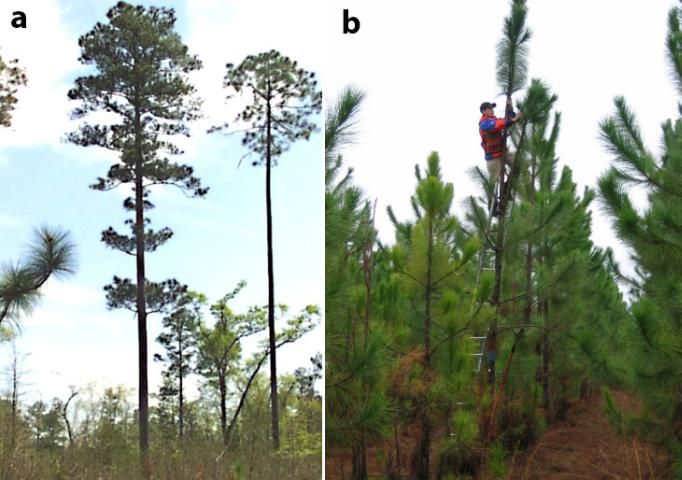
Credit: All images by the authors
Step 2. Grafting Superior Plus-Trees into Seed Orchards—Production Population
After plus-tree selection, branch tips from the best plus-trees are collected by shooting branches out of the plus-tree, climbing the plus-tree, or cutting branch tips using pole pruners. These branch tips (called scions) are then grafted onto seedlings (called rootstock) that are planted in a central location called a seed orchard (Figures 2a and 2b). Scions collected from plus-trees have the exact same genetic make-up as the plus-tree from which they were collected. Grafting scions from plus-trees creates copies of the plus-trees, and these copies together form a clone of the plus-tree.
All plus-tree selections have different levels of genetic gain. The superiority of a seed orchard and the seed varieties produced in a seed orchard depends on the genetic gain of all the plus-tree selections that are grafted in the seed orchard. Therefore, each seed orchard produces seeds having different levels of genetic gain. Some seed orchard managers group clones in their seed orchard by their superior growth rate, disease resistance, and both growth rate and disease resistance (Figure 2b). Then they collect cones from these different groups (Figure 2c). The cones are sent to seed-extraction plants, where the cones are processed and seeds are extracted by group. The seed can then be marketed as improved for growth, improved for disease resistance, or improved for both growth and disease resistance.
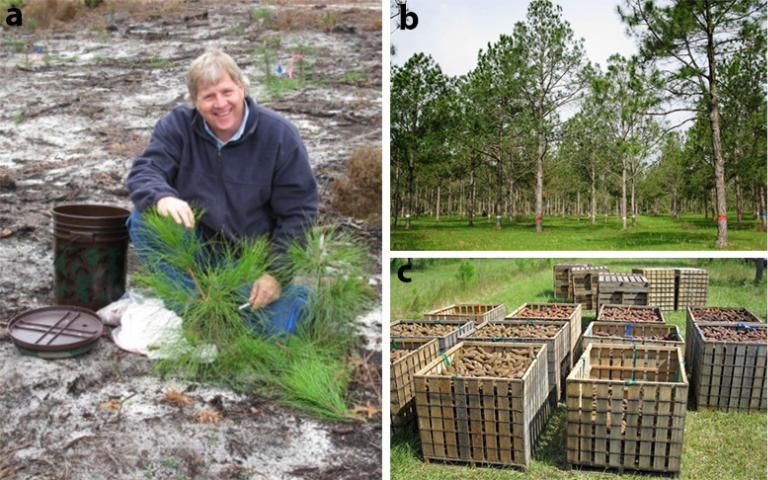
Credit: All images by the authors
Most seed is produced by random intermating among the clones in the seed orchard, which produces open-pollinated seed where only the identity of the mother parent is known. The father could be a tree growing in the seed orchard or one growing outside the seed orchard. Seeds get half of their genes from their female parent and half from their male parent. Therefore, seed produced in seed orchards are genetically improved because we know that at least their mother parent is improved. In general, seedlings produced from seed-orchard seeds grow faster and healthier than unimproved seedlings grown from wild seed.
Sometimes seed orchard managers put isolation bags over female flowers of their better seed orchard trees (those with desirable growth rate, disease resistance, or form) before the flowers are receptive to the male pollen (Figure 3a). When the female flowers are receptive, the isolation bags are injected with pollen from a single parent or a mixture of pollen from multiple parents that are better for growth, disease-resistance, or form (Figure 3b). This can result in the production of improved full-sib families of seed where the male and female parents are known and both are improved. This method of seed production is called mass control pollination (MCP) or control mass pollination (CMP). It is a more labor-intensive method of producing seeds, but the resulting seed often has higher genetic gain because only the very best clones are used as mother and father parents. When the cones mature (19 months later) nursery managers collect and sow the seed from these improved families by family, producing even better genetically improved seedlings that can be purchased and used for reforestation (Figure 4).
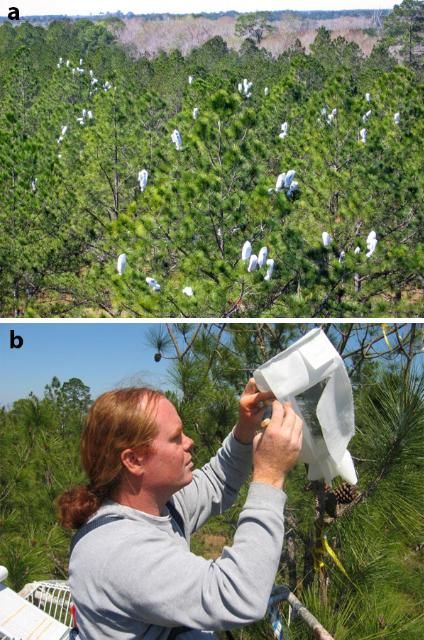
Credit: All images by the authors
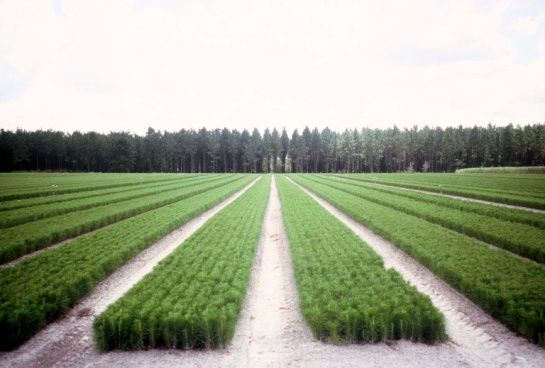
Credit: All images by the authors
A first-generation or first-cycle seed orchard is one in which the clones are grafted from first-generation selections. If the clones are from second-generation selections, then the seed orchards developed are called second-generation or second-cycle seed orchards, etc. Collectively, seed orchard clones are called the production population.
Step 3. Field Testing the Plus-Trees—Tested Population
First-generation plus-trees chosen from natural stands are selected solely on the basis of their external appearance, called the phenotype. The phenotype is influenced by many factors including the tree's growing environment and genetic make-up (genotype). Some plus-trees selected in natural stands have superior phenotypes mainly due to factors other than genetics such as fertile soil pockets, more light, or other favorable environmental conditions where they are growing. Other plus-trees may have superior phenotypes based mainly on their genetic make-up. Still other plus-tree selections are more genetically superior than their outward appearance may indicate.
To quantify the genetic superiority of each plus-tree, it is necessary to create several field tests (named progeny tests), to measure the performance of a plus-tree's progeny (offspring) and analyze that performance to judge the genetic value and ranking of the parent tree (Figure 5). Simply put, if a plus-tree's seedlings perform well in several progeny tests having, perhaps, different soil and climatic conditions, it reflects well on the genetic value of the plus-tree.
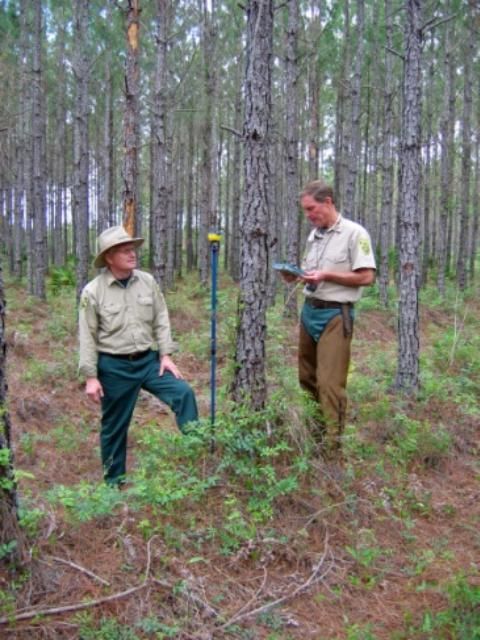
Credit: All images by the authors
This ranking process is also used to increase the genetic superiority of the varieties available for reforestation. Plus-trees in seed orchards are evaluated in progeny tests, and inferior plus-tree clones are removed (rogued) from the seed orchards so that only the proven superior plus-tree clones are allowed to remain and contribute pollen and seed in the rogued orchards. Tested plus-tree clones and seedlings are called the tested population.
Step 4: Continued Improvement and Development of Still Better Varieties
Tree breeding programs intermate superior genotypes and screen their offspring in progeny tests in order to locate new selections that combine the best attributes of both parents. The full-sib offspring produced receive half of their genetic make-up from the female parent and half from the male parent but are not identical genotypes just as human brothers and sisters are different. These full-sib families are planted out in field progeny tests resembling a forest plantation. The field progeny tests are managed like normal pine plantations, and each tree is measured for its growth and disease resistance. The data are analyzed, and the tests are screened to locate new plus-tree selections that have received the best genes from their parents. Making these new selections marks the end of one generation or cycle of breeding and the beginning of the next generation or cycle of breeding.
Choosing the Best Genetically Improved Seedlings for Reforestation
Landowners seeking to regenerate a site with pines face two genetic decisions:
- Selection of the appropriate pine species and seedling type; and
- Selection of the best available genetic variety of the species to plant on the site.
Planting the appropriate pine species and best available genetic variety can result in a plantation that generally grows faster, is more disease resistant, has improved tree form and thus increases the value of the planted forest.
Selecting the Right Pine Species and Seedling Type
Matching the right pine species to the site is a critical first step. Planting a species on an inappropriate site can result in higher mortality, poor tree form, and stagnated growth. For example, there have been several plantings of slash pine on sand hill sites that grew poorly because the planting site was not suitable for slash pine. The selection of species for a site is based on factors such as: soil characteristics (texture, drainage), final products desired (pulpwood vs lumber), planned silvicultural treatments (such as bedding and fertilization), and the presence of diseases and insects (especially fusiform rust, pitch canker, southern pine beetle, and brown–spot needle blight).
To help determine the best species to plant on a site, landowners may first consult with their local professional private, state, or county forester and, when available, use assistance programs. It may also be useful to observe neighboring forest plantations to see what species are doing well on those sites. When regenerating a cut-over site, if the species used in the previous plantation grew well on the site and met the landowner's objectives, that species may be the best choice for the next plantation.
After determining what pine species to plant, landowners need to decide whether to plant bare root seedlings (roots not contained in soil) or containerized seedlings (roots contained in soil). The majority of pine seedlings planted in Florida are bare root seedlings (Figure 4), although some forest tree nurseries do have containerized seedlings available for some pine species (for example slash, loblolly, and longleaf pine). Planting containerized seedlings on a site—for example, longleaf pine—can sometimes result in better planting survival and faster initial growth; however, containerized seedlings do cost more. Landowners should weigh the costs and benefits of planting containerized seedlings.
Selection of the Best Available Variety
The next step is to find the best genetically improved variety available for planting. Forest tree seedlings that are improved for growth, disease resistance, form, and sometimes other desirable traits may be purchased at the forest tree seedling nurseries listed in Table 2. A landowner may call these nurseries to inquire about available stock, their degree of genetic improvement, and how to place a seedling order. If the nursery is conveniently located, it is wise to arrange for a nursery visit to see how the seedlings are produced and how seedling genetic quality is tracked.
Forest tree nurseries often describe their seedlings as "Improved for Growth" or "Improved for Rust Resistance" or "Improved for both Growth and Rust Resistance." Improved means the seed came from an improved seed orchard (1.0 generation, 2.0 generation, 3.0 generation, etc.). Yet, not all "Improved" varieties have the same genetic superiority. A more informative way to describe an improved variety for growth is by expressing its volume or genetic gain for volume as a percent improvement above an unimproved variety planted on an average site at time of harvest (usually 20–25 years of age). For example, planting a site with a variety that has a volume or genetic gain for volume of 25%, means that at harvest, the site should yield 25% more wood volume than if the site were planted with an unimproved variety. An informative way to describe an improved variety for rust resistance is the R50 value. The R50 value is the amount of rust infection an improved variety would get if planted in an area where an unimproved variety would get 50% infection. For example, a variety that has a R50 of 30% means that the variety would get 30% rust infection if planted in an area where unimproved material would get 50% rust infection.
When purchasing seedlings from a forest tree nursery, the landowners should ask forest tree nursery managers what varieties of the desired species they have that are suitable for planting on their land and what the expected level of superiority for yield and/or disease resistance is for those varieties. Most forest nurseries have several varieties suitable for planting in different locations and have different expected levels of gains and different costs. Varieties with higher gains or higher levels of improvement may be priced higher; so landowners should weigh the cost versus the benefits for each of the available varieties. By knowing the expected gains for the different varieties of pine that are available and which varieties will grow best on their land, landowners can be sure to get the best variety for planting on their site.
Summary
By planting the appropriate pine species and varieties with the best genetic improvement and using the right silvicultural practices, landowners can ensure that they will have the best possible pine productivity and health on their lands. Like breeding programs of other species, tree breeding programs are continuous and ongoing. The CFGRP slash and loblolly pine programs continue to improve yield, disease resistance, and tree form while maintaining a breeding program with a broad genetic diversity. Landowners can get help reforesting their site from their local professional private, state, or county forester, and, if available, local industrial landowner assistances programs.
More information on the CFGRP tree-improvement program can be found by visiting their website at: https://programs.ifas.ufl.edu/cfgrp/. Additional information on forest genetics and tree improvement can be found in the book "Forest Genetics" by T.L. White, W.T. Adams and D.B. Neale, 2007.
Acknowledgments
Drs. Tim White and Mary Duryea wrote the original document published as CIR 1190, June 1997, School of Forest Resources and Conservation, Florida Cooperative Extension Service, Institute of Food and Agricultural Sciences, University of Florida. The original document was revised in 2017 by Greg Powell.